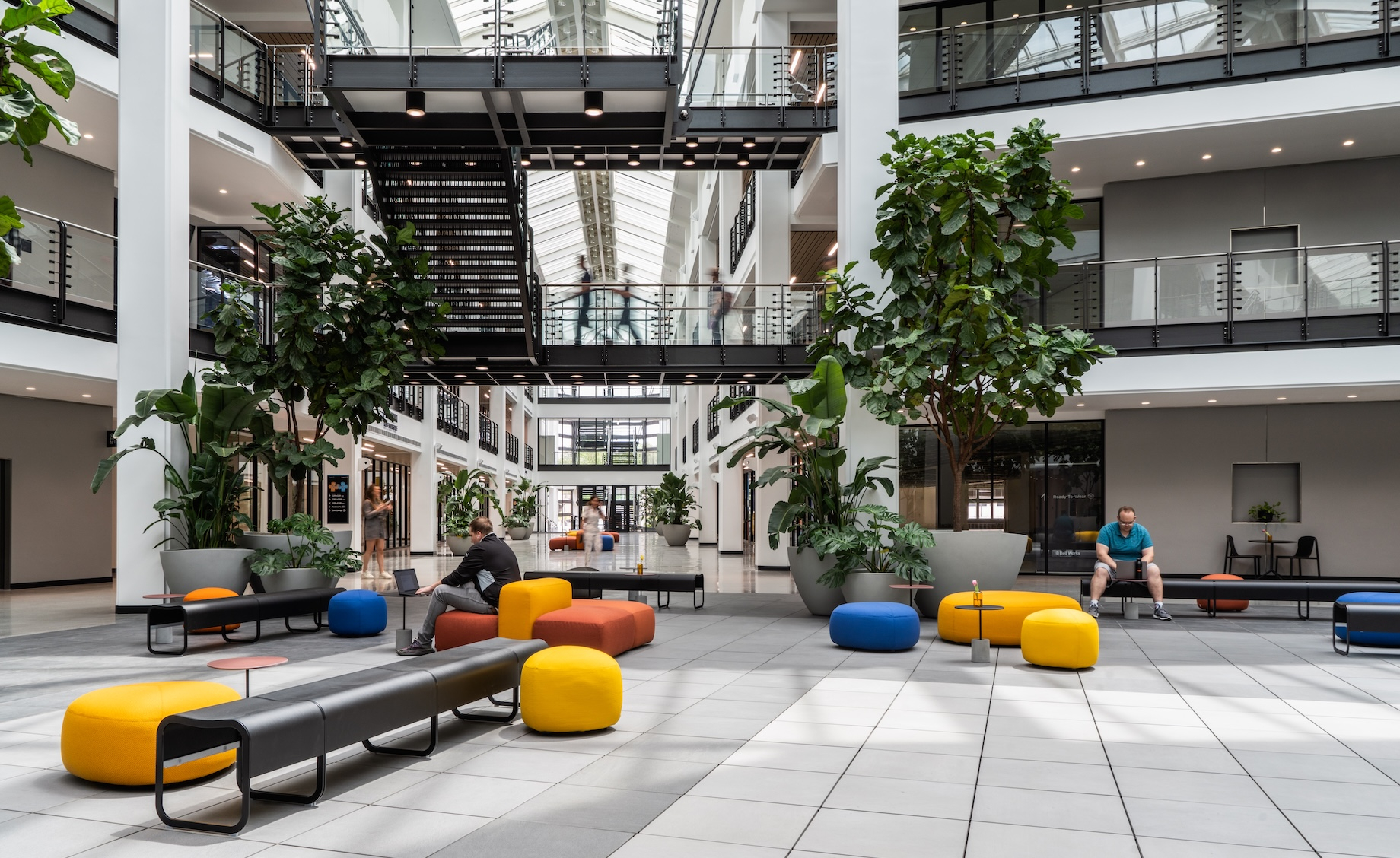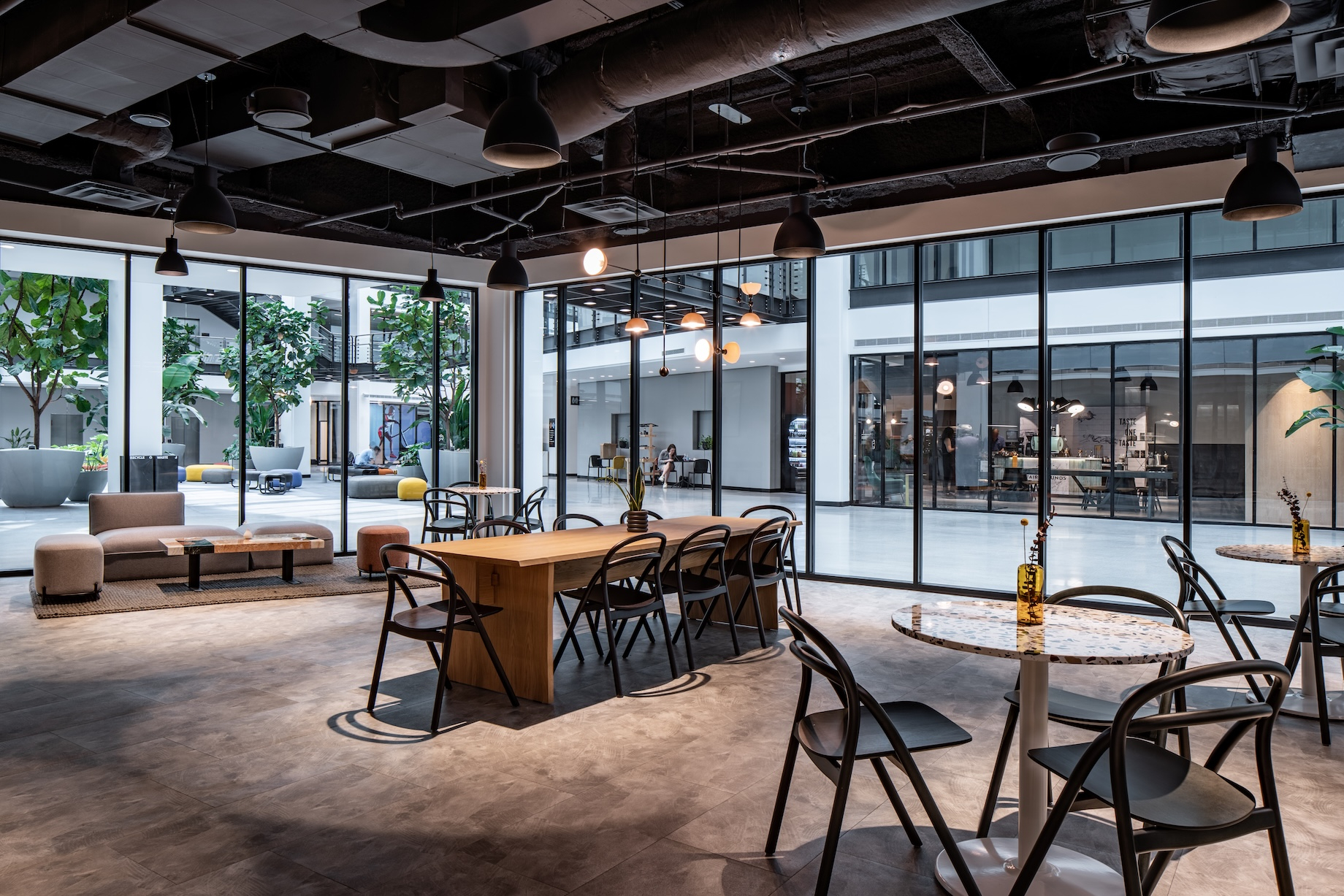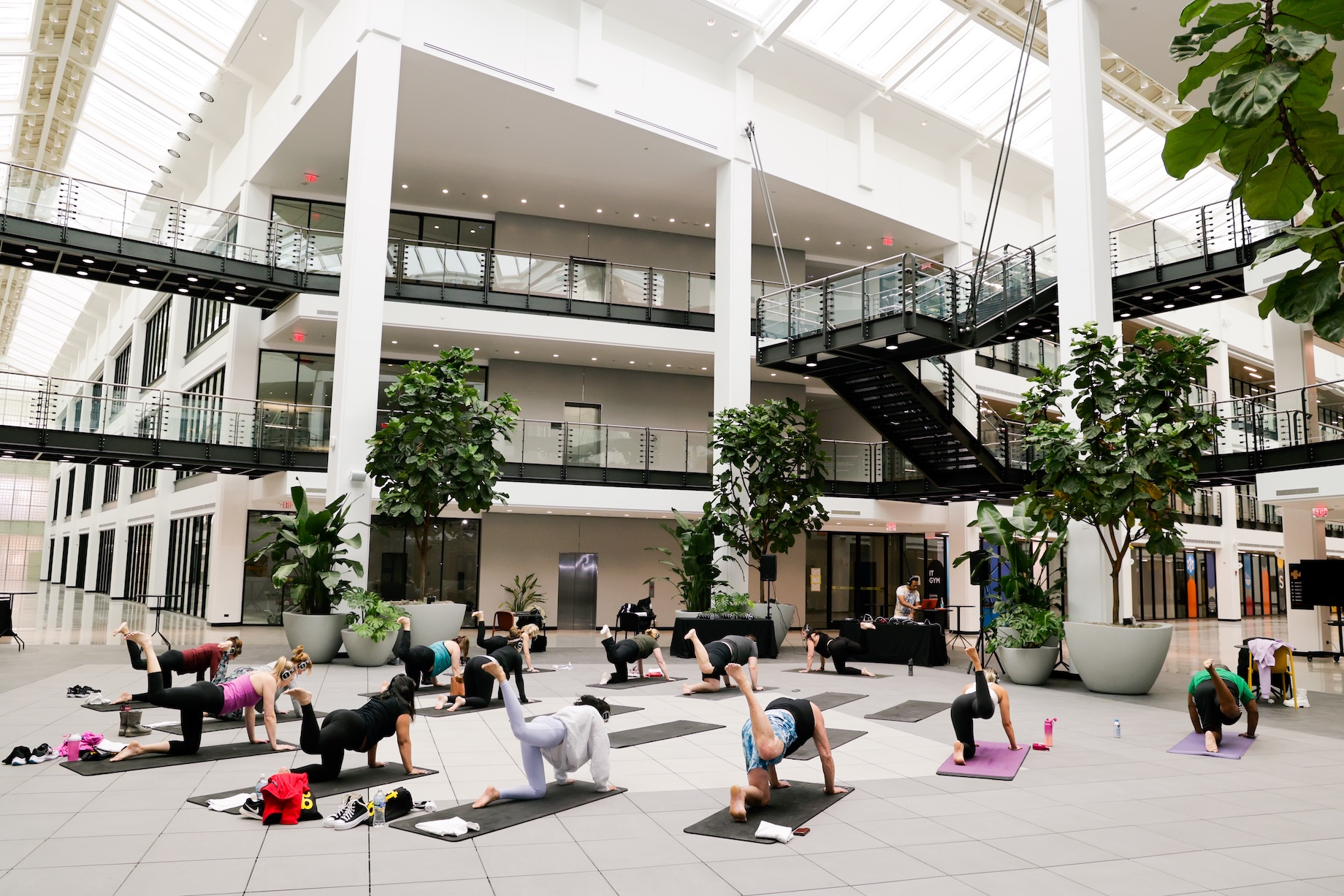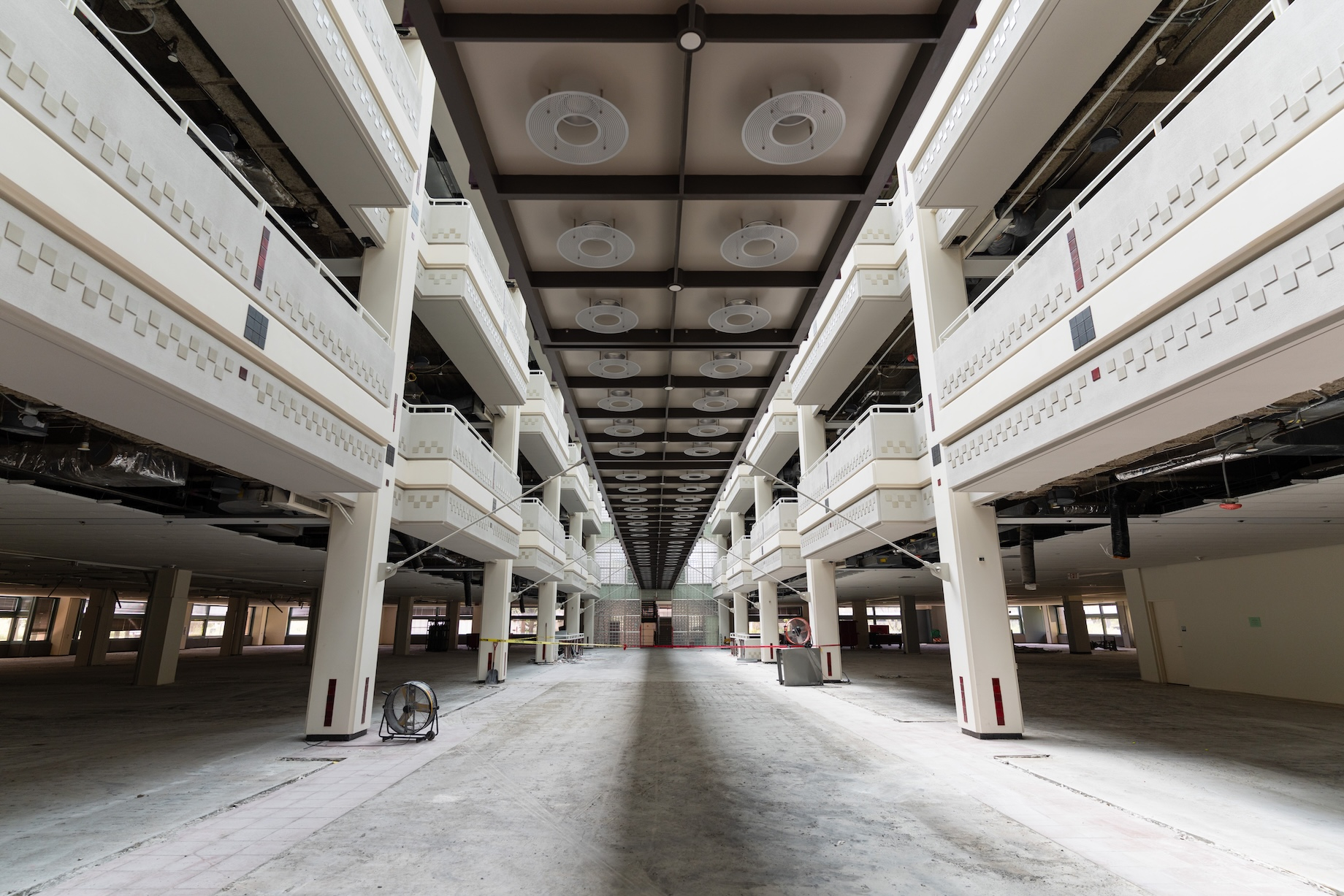The Short Version
- The metroburb model from Ralph Zucker’s Inspired by Somerset Development transforms vacant suburban office campuses into mixed-use community hubs.
- Bell Works Chicagoland redeveloped a former AT&T headquarters into a $200 million destination with offices, retail and amenities.
- A tax increment financing (TIF) partnership with the village of Hoffman Estates helped make the project financially feasible.
- Community amenities like parks, retail, fitness, food halls and events attract both tenants and visitors.
- Phase 1 of Bell Works Chicagoland is more than 90% leased.
- New housing developments, including townhomes and apartments, will complete the live-work-play vision.
- Construction is underway on Phase 2, which will add offices, retail and new amenities in 2026.
- Lessons from Bell Works’ New Jersey flagship informed Chicagoland, with a third metroburb planned in Tinton Falls, New Jersey.

From Abandoned Office to Community Anchor: The Metroburb Approach
Ralph Zucker has a solution for how to backfill empty headquarters buildings dotting suburbia: Build a metroburb.
That’s what the founder and CEO of Inspired by Somerset Development calls the reinventions of massive, underutilized office structures into community hubs with retail and other uses. He’s brought two metroburbs to life, and a third is on the drawing board.
The second, Bell Works Chicagoland, is a $200 million remake of the 1.6 million-square-foot former AT&T headquarters campus in Hoffman Estates, Illinois. The project earned Zucker’s firm a 2025 ICSC Excellence in Community Advancement Award in the Urban/Suburban Redevelopment category. The newly created program recognizes public-private partnerships.
More 2025 ICSC Excellence in Community Advancement Award Winners
How a Public-Private Partnership — and a Court Battle — Shaped Nine Mile Corner
How a 40-Year Partnership Brought a $400M Resort and a Museum to Oklahoma City
PGA Frisco: A Public-Private Partnership Driving North Texas’ Mega Mixed-Use Development
How Hernando, Mississippi, Turned Brownfields Into a Blueprint for Small-Town Revival
The flagship Bell Works metroburb is in Holmdel, New Jersey. At each development, Inspired has activated the ground floors with shops, restaurants, education centers, markets, fitness studios, healthcare providers and more; renovated the above office spaces; and added adjacent residences. The original Bell Works and the completed Phase 1 of Bell Works Chicagoland both are more than 90% leased, Zucker said.
The Metroburb Model: Reimagining Empty Suburban Campuses
Zucker describes his metroburb model as “a self-contained metropolis in suburbia that perfectly addresses the new world we cater to and answers the question of what to do with all these large corporate campuses that are now way too large for one user and have become increasingly irrelevant,” he said. “The metroburb also addresses the conundrum of how to get people back in the office post-pandemic and even from pre-pandemic, when a shift away from the office market was already apparent.”

Natural light and splashes of color in common areas highlight the experience at Bell Works Chicagoland, a remake of the former AT&T headquarters in the Chicago suburb of Hoffman Estates. Photo courtesy of Bell Works Chicagoland
Acquiring and Repositioning the Former AT&T Campus
Inspired bought the Hoffman Estates campus, which included a separate 60,000-square-foot office building and 40,000-square-foot warehouse, in 2019 after it had sat vacant for three years. The $21 million price was a steep discount from the $338 million for which the property sold in 2005. Phase 1 of Bell Works Chicagoland opened in 2021. The “Bell” in the name references, not AT&T but the first metroburb, a 2015-delivered redevelopment of Bell Labs’ campus in New Jersey.
From Pandemic Setback to New Office Community
Bell Works Chicagoland got off to an inauspicious start. Zucker estimates his firm lost two years due to COVID. “Because of the timing of buying the building just before COVID, it took a while for the business community to understand what direction we were heading and for us to gain any kind of leasing momentum,” he said.
That changed as Zucker’s team educated the market on the metroburb concept. Bell Works Chicagoland now has leased around 400,000 of the 420,000-square-foot Phase 1, the core building’s east side.
Leasing Momentum Builds at the New Bell Works Chicagoland
In 2022, branding and marketing firm Club Colors departed neighboring Schaumburg to take over more than 52,000 square feet of office on Bell Works Chicagoland’s third floor, plus 35,176 square feet of light-assembly production space on the first floor. The move enables Club Colors to house all 125 sales and production workers under a single roof for the first time.
This year, security-system designer Convergint, an existing tenant specializing in technology solutions, expanded its footprint at Bell Works Chicagoland from 65,000 square feet, adding 17,400 square feet of office and 10,000 square feet of warehouse space. And Swedish medical-device supplier Arjo exited a lease in nearby Addison, Illinois, four years early in favor of 35,600 square feet at Bell Works Chicagoland, according to Colliers, which brokered the transaction on behalf of both parties. Other tenants include Crystal Clean at 39,000 square feet, Platinum Home Mortgage at 22,000 square feet and Headline Solar at 15,690 square feet with an option for 15,000 more.
The hottest Bell Works Chicagoland office spaces are between 400 square feet and 4,000 square feet, said Zucker. “Many smaller companies have reduced their footprints as they’ve become more comfortable with our spaces.”

A CoLab co-working space at Bell Works Chicagoland. Photo courtesy of Bell Works Chicagoland
From Parks to a Food Hall: Community Amenities Drive Appeal
Zucker said amenities like spacious parks, a 31,680-square-foot Kinema Fitness, eateries, co-working spaces like the 3,000-square-foot CoLab and the Bell Market food hall that opened in July have boosted the appeal not just to office tenants but also to the community. The building also includes a first-floor town square, open to commercial tenants and the public, that hosts recurring farmers markets and entertainment operators like Swing Loose Indoor Golf and Game Night Out.

Yoga and other fitness classes in a common area are among the amenities on offer to office and industrial tenant employees. Photo courtesy of Bell Works Chicagoland
As companies consider relocations, Bell Works “is reinventing office and mixed-use to be a place where employees want to come back to the office, plus where a community can come together to create lasting memories,” said Kevin Kramer, economic development director for the village of Hoffman Estates.
New Housing Will Complete Chicagoland’s Live-Work-Play Vision
For the grounds surrounding the existing commercial buildings, Pulte Homes broke ground on 164 luxury townhomes in March. Inspired submitted plans for a 300-unit apartment complex in April. “Community demand for these living spaces is off the charts,” Zucker said. Added Kramer: “The residential component completes the model for a metroburb, which has successfully created an urban live-work-play-create feel in Hoffman Estates.”
Lessons From the Holmdel Flagship Shape Chicagoland
Zucker knew what to expect at Chicagoland after developing the original Bell Works metroburb in New Jersey, where he had spent five years obtaining approvals and entitlements. He attended dozens of town halls and hosted a “block party” in the atrium to showcase the former research building’s potential. “It took a while to gather steam, but once we did, we soon reached critical mass, finding an amazing human scale there,” he said.
The facility functioned for 44 years as a research-and-development facility for the Bell System and later for Bell Labs. Zucker first toured it in 2008 and took over in 2013. He described the original building design, from Eero Saarinen, as having “brilliant clarity of linear space.”
To help fund the New Jersey redevelopment, Inspired sold off a parcel to Toll Brothers, which constructed 185 homes for buyers age 55 and over and 40 single-family homes.
Today, the nearly full Bell Works — which readers might recognize from its appearances in the TV show Severance and other productions — is seen as one of the great suburban “downtowns” in New Jersey, Zucker said. In addition to an indoor pedestrian street with eateries, retail and entertainment, the project features a public library, a Montessori school, basketball courts, a pet spa and the 285-seat Bell Theatre, which is open to the public. A collaboration between Bell Works and the local Axelrod Performing Arts Center, the theater features musicals, plays, concerts, comedy, jazz and family entertainment, all open to the public.
A TIF Partnership Helped Create Bell Works Chicagoland
The village of Hoffman Estates approached Zucker about using a similar adaptive reuse approach for the AT&T building, Zucker said. According to Kramer, Hoffman Estates officials realized they needed to find a developer with the capital, creativity and experience “to create something more than the typical reuse and occupation of an office building,” he said. “Inspired had all three with their Bell Works model.”
Hoffman Estates established a tax increment financing district as a primary incentive to help move the development forward, Kramer said. “The property tax increment generated by the project goes back into a fund where a portion is shared with the developer,” he explained. The TIF froze property taxes at current rates on the commercial portion of the Bell Works redevelopment. Property taxes on the housing portion of the development are not frozen.
The TIF went into effect in 2019 and expires in 2042, so Inspired will not have to pay higher taxes based on the value it creates for another 17 years. Any increase in tax revenue — say from Bell Works Chicagoland residences or from rising property values around the project — will service the infrastructure and improvement debt that the village of Hoffman Estates incurs related to the project, according to Valbridge Property Advisors, which appraised the property.
“It’s estimated that the TIF will fund around 30% of the total project cost after complete buildout,” Kramer said. Zucker added of the village of Hoffman Estates: “From the beginning, they turned out to be an enthusiastic partner to work with, and they’ve always kept their focus on the goal, creating a TIF and aggressively promoting our project.”
Phase 2 Expansion Will Grow Bell Works Chicagoland
Zucker soon will have more space to flesh out. Inspired broke ground this summer on Bell Works Chicagoland’s west side, a mirror expansion of the east side that will connect to and expand the main street-style interior corridor begun in Phase 1 and add 430,000 square feet of office, Zucker said, including about 35,000 square feet of what he calls “ready-to-wear” furnished office suites. Among the amenities will be a rooftop bar, a cafe and 70,000 square feet of new retail. Many retail, office and restaurant spaces in Phase 2 will be ready for occupancy by late 2026, he said.

Bell Works Chicagoland’s Phase 2 will include 430,000 square feet of office and 70,000 square feet of retail. Photo courtesy of Bell Works Chicagoland
Why Chicago Embraced the Metroburb Redevelopment Model
As Zucker was considering expansion into the Chicago area, he was encouraged by the mixed-use remake of the city’s landmark nine-story, 2.5 million-square-foot Old Post Office. Now home to corporate offices for Walgreens, PepsiCo, Ferrara Candy Co. and Uber, plus numerous restaurants and retailers, the project signaled a strong local appetite for adaptive reuse. “It showed me the Chicago area was willing to embrace new approaches,” he said.
But lenders, many saddled with debt from the office downturn, initially were skeptical of Bell Works Chicagoland, he said. They slowly bought in, however, convinced that today’s office workers are drawn to “walkable and amenity-rich destinations that allow them to integrate their work and personal lives seamlessly.”
The brokerage community caught on, too. “They’ve been good to us because they realize we have a winning project,” Zucker said. “Before, we had to help people imagine what this place could be. Now, they can see it in action: a place where people work, dine, shop, play, connect and innovate.”
On the Horizon: Tinton Falls Will Become the Third Metroburb
While there are other existing structures across the U.S. where a metroburb might work, “not many have the right bones or the right locations,” Zucker explained. One that does is about 10 miles from the Holmdel campus, in Tinton Falls, New Jersey, where Inspired purchased Commvault’s headquarters in January. The data-protection company, which once occupied the full 276,900 square feet, will lease back approximately 75,000, meaning the nation’s third metroburb will be a quarter leased before redevelopment even begins.
By Steve McLinden
Contributor, Commerce + Communities Today